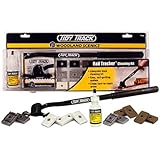I was looking for a way to store rolling stock so that it was protected, out of the way, but easy to access when operations required.
The idea of a wall mounted display box appealed, so I set to it one Saturday morning.
The Wooden Wine Box
Somebody had given me some wine (3 bottles) that happened to come in a box with separators. I think it was because there was a red, white and rosé, or perhaps two reds and a white.The important point about this is that there are two drilled slits in the wooden sides, which contain the separators.
This makes them easy to slip out and, say, stick some model railway tracks on them.
Having tried a number of configurations, using some old Hornby track that I bought at a model rail show -- and had clearly been part of a house clearance -- it quickly became clear that trying to hot-glue them to the wood wasn't a great idea.
By a similar token, trial and error led me to the following bits of advice...
Placing Rails
Although it's tempting, don't try to place the rail as close as possible to the back of the box, in the hope that you'll get twice as much track in. It's obvious when you think about it, but most rolling stock is wider than the OO standard sleeper width.This overhang caused me to curse and then try to remove the tracks from the wood (I'd glued them down) because the coal trucks I'd chosen to display were too wide, and wouldn't sit on the rails properly.
I'd also chosen to hot glue the tracks down. Not a mistake I'll ever make again: it's impossible to rip up without damage.
On top of which, if you double the track, not only do the trains / trucks rub up against each other, there also isn't quite enough space to reliably remove stock from the back, so you end up removing the front items as well!
It turns out, however, that placing the rails in the middle, and making sure that there's space at either end to slide it into the box, makes for a neat plinth-like presentation.
Being removable, if you put buffers (or just a retaining screw) at each end, you can also slide them out (except the bottom one) to swap stock around.
Wall Mounted
The final step was to drill a couple of holes in the box: I didn't measure, which I regret for two reasons:- It doesn't look symmetrical;
- I didn't leave enough space in the corners to drill through and mark the wall, and there wasn't enough space to use the electric screwdriver to mount the box.
The moral of the story is: if you're going to drill from the back, measure, and make sure there's space when you need to screw it to the wall to get the drill / screwdriver in the corner.
Still, I'm pleased with the result, and I'll add a photo of the installed case, complete with all my coal trucks in it as soon as it's up.
Meanwhile, I'm thinking about putting some low-voltage LED strip-lighting along the understanding of the shelves to light the wagons up, but before I do that I figure a lick of paint wouldn't go amiss.
But, it's a case of having enough time to 'get around to it'.
My next weekend project is to build a test track / workbench with space to mount my Hornby Elite so that there's also space for a computer to help with automated layout control and DCC programming. Fun times...
Comments as always welcome, and if you're looking for somewhere to get wine boxes, I've linked to a Gumtree search in the Resources section below.









 Essentially, there are three different approaches to cleaning track, one of which (the electronic cleaner) is more about prevention than cure.
Essentially, there are three different approaches to cleaning track, one of which (the electronic cleaner) is more about prevention than cure.


